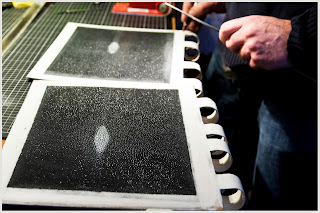De "reliure Hollandaise" of spitselband is vermoedelijk ontstaan in de 16 de eeuw. Deze bindwijze was toen in bepaalde opzichten vernieuwend. Enerzijds door het gebruik van perkament voor de omslag, een materiaal dat tot dan toe ontbrak. Anderzijds door het gebruik van "spitsels" en de "yappen" maar daarover later meer.
De eerste beschrijving van deze techniek vinden we bij Anshelmus Faust. Faust schreef in 1612 het oudste traktaat volledig gewijd aan het beschrijven van boekbindtechnieken: "Beschrijvinghe ende onderwijsinghe ter discreter ende vermaerder consten des boeckbinders handwerck". Het is dus niet, zoals veelal verkeerdelijk wordt aangenomen, het "Kort onderweijs in het boeckenbinden" uit 1658 van Dirk de Braij die als oudste beschrijving mag bestempeld worden. Faust was een Duitse boekbinder actief in het Antwerpse, en werkte o.a. voor Plantin-Moretus. Hij richtte zijn geschrift aan de de toenmalige Sint Bernards abdij in Hemiksem, waarschijnlijk als een soort solicitatiebrief om zijn kunnen te demonstreren. Het handschrift (gebonden in een dos-à-dos) van Faust wordt momenteel bewaard in het
Plantin Moretus Museum te Antwerpen. In 1987 werd het handschrift heruitgegeven door Bibliotheca Wittockiana als 2de deel in de reeks "Studia Bibliotheca Wittockianae", zie bovenstaande foto.
De spitselband is lange
tijd als kneusje onder de boekbanden beschouwd en aangenomen kan worden dat de spitselband uit het vizier verdween in de loop van de 19 de eeuw. Toen in 1966 de overstromingen
in Florence plaatsvonden kwamen de perkamenten banden (letterlijk) terug boven
water. C. Clarkson stelde vast dat vele lijmloze perkamenten banden niet alleen
de afgelopen eeuwen maar ook de overstromingen beter hadden overleefd dan
andere boekconstructies. Clarkson bestudeerde perkamenten banden & hun
constructie uitvoerig en publiceerde zijn bevindingen in een aantal artikels.
Sindsdien worden deze banden als volwaardig beschouwd.
Tegenwoordig wordt de perkamenten band hoofdzakelijk toegepast als lijmloze conservatieband, al nodigt de
doorzichtigheid van het perkament ook uit tot meer creatieve banden.
The "reliure Hollandaise" or" spitselband" probably originated in the 16th century. This binding method is at that time, innovative in some respects. Firstly, by the use of parchment for the cover, a material that was hitherto lacking as coveringmaterial. On the other hand through the use of "spitsels" and "yappen". But more on that later.
The first description of this technique, you can find at Anshelmus Faust. Faust
wrote in 1612 the oldest treatise dedicated to describing bookbinding
techniques:"Beschrijvinghe ende onderwijsinghe ter discreter ende vermaerder consten des boeckbinders handwerck". It
is not, as mostly assumed, "Kort onderweijs in het boeckenbinden" from 1658 by Dirk de Braij which may be labeled. as oldest
description. Faust was a German bookbinder active in Antwerp. He
made his writings to the former St. Bernard Abbey in Hemiksem,
probably to demonstrate his skills. The manuscript (bound in a dos-à-dos) of Faust is currently preserved in the Plantin Moretus Museum in Antwerp. In
1987 the manuscript was reissued by BibliothecaWittockiana as 2nd part
in the series "Studia Bibliotheca Wittockianae", see picture above.
The
spitselband has long been regarded as minor. It seems to be the spitselband disappeared from sight in the course of the 19th
century. When in 1966 the floods in Florence took place the vellum bindings were (literally) back above water. C. Clarkson
noted that many glueless vellum bindings also had not only the past
centuries but the floods survived better than other book structures. Clarkson studied vellum bindings and their construction in detail and published his findings in a number of articles. Since then, these bands considered as an important conservation binding technique.
.JPG)
.JPG)


.JPG)




.JPG)








